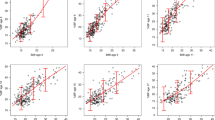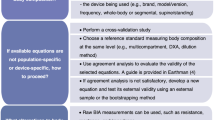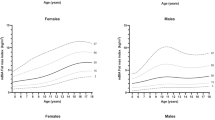Abstract
Background/Objectives
Obesity in early childhood is associated with increased risk of chronic diseases, but studies of body composition at preschool ages are sparse. Therefore, we examined differences in body composition by sex and obesity status in Finnish preschool-aged children and within-individual changes in body composition in normal and overweight children.
Subject/Methods
Body composition was measured using segmental multifrequency bioimpedance analysis (BIA) in 476 children and in 781 children at age 3 and 5 years, respectively. Of those, 308 had repeated BIA measurements at both ages. BMI-SDS was used for classification of normal weight and overweight children.
Results
Sex difference in the amount of lean mass (LM) was already seen at 3 years of age (boys 11.7 kg, girls 11.3 kg; p < 0.001). At 5 years of age, boys had lower fat mass (FM; 3.6 kg vs. 3.9 kg, p < 0.001), lower percent fat mass (%FM; 17.2% vs. 19.1%; p < 0.001), and higher LM (16.0 kg vs. 15.2 kg; p < 0.001) than girls. Overweight children had higher values in FM, %FM, and LM compared with normal weight peers at both ages. Among normal weight children, the increase of LM by age was associated with only minor changes in FM, whereas children who were or became overweight both LM and FM was substantially increased between 3 and 5 years of age.
Conclusions
BIA-assessed body composition differs by sex and obesity status already at age of 3 years. For children who are or become overweight at very young age, the patterns for the changes in LM and FM by age are different than for normal weight children.
This is a preview of subscription content, access via your institution
Access options
Subscribe to this journal
Receive 12 print issues and online access
$259.00 per year
only $21.58 per issue
Buy this article
- Purchase on Springer Link
- Instant access to full article PDF
Prices may be subject to local taxes which are calculated during checkout




Similar content being viewed by others
References
Sahoo K, Sahoo B, Choudhury AK, Sofi NY, Kumar R, Bhadoria AS. Childhood obesity: causes and consequences. J Fam Med Prim Care. 2015;4:187–92.
Mei Z, Grummer-Strawn LM, Pietrobelli A, Goulding A, Goran MI, Dietz WH. Validity of body mass index compared with other body-composition screening indexes for the assessment of body fatness in children and adolescents. Am J Clin Nutr. 2002;75:978–85.
Cole TJ, Lobstein T. Extended international (IOTF) body mass index cut-offs for thinness, overweight and obesity. Pediatr Obes. 2012;7:284–94.
Wells JCK. Toward body composition reference data for infants, children, and adolescents. Adv Nutr. 2014;5:3205–95.
Kyle UG, Earthman CP, Pichard C, Coss-Bu JA. Body composition during growth in children: limitations and perspectives of bioelectrical impedance analysis. Eur J Clin Nutr. 2015;69:1298–305.
Ogden CL, Carroll MD, Lawman HG, Fryar CD, Kruszon-Moran D, Kit BK, et al. Trends in obesity prevalence among children and adolescents in the United States, 1988-94 Through 2013-2014. JAMA. 2016;315:2292.
Chula de Castro JA, Lima TR, de, Silva DAS. Body composition estimation in children and adolescents by bioelectrical impedance analysis: a systematic review. J Bodyw Mov Ther. 2018;22:134–46.
Tompuri TT, Jääskeläinen J, Lindi V, Laaksonen DE, Eloranta AM, Viitasalo A, et al. Adiposity criteria in assessing increased cardiometabolic risk in prepubertal children. Front Endocrinol. 2019;10:1–12.
Mast M, Langnäse K, Labitzke K, Bruse U, Preuss U, Müller MJ. Use of BMI as a measure of overweight and obesity in a field study on 5-7 year old children. Eur J Nutr. 2002;41:61–67.
Maynard LM, Wisemandle W, Roche AF, Chumlea WC, Guo SS, Siervogel RM. Childhood body composition in relation to body mass index. Pediatrics. 2001;107:344–50.
Alves Junior CA, Mocellin MC, Gonçalves ECA, Silva DA, Trindade EB. Anthropometric indicators as body fat discriminators in children and adolescents: a systematic review and meta-analysis. Adv Nutr Int Rev J. 2017;8:718–27.
Javed A, Jumean M, Murad MH, Okorodudu D, Kumar S, Somers VK, et al. Diagnostic performance of body mass index to identify obesity as defined by body adiposity in children and adolescents: A systematic review and meta-analysis. Pediatr Obes. 2015;10:234–44.
Delisle Nyström C, Henriksson P, Ek A, Henriksson H, Ortega FB, Ruiz JR, et al. Is BMI a relevant marker of fat mass in 4 year old children? Results from the MINISTOP trial. Eur J Clin Nutr. 2018;72:1561–6.
Singh AS, Mulder C, Twisk JWR, Van Mechelen W, Chinapaw MJM. Tracking of childhood overweight into adulthood: A systematic review of the literature. Obes Rev. 2008;9:474–88.
Mialich MS, Maria J, Sicchieri F, Afonso A, Junior J. Analysis of body composition: a critical review of the use of bioelectrical impedance analysis. Int J Clin Nutr. 2014;2:1–10.
Tompuri TT, Lakka TA, Hakulinen M, Lindi V, Laaksonen DE, Kilpeläinen TO, et al. Assessment of body composition by dual-energy X-ray absorptiometry, bioimpedance analysis and anthropometrics in children: the Physical Activity and Nutrition in Children study. Clin Physiol Funct Imaging. 2015;35:21–33.
Staiano AE, Broyles ST, Gupta AK, Katzmarzyk PT. Ethnic and sex differences in visceral, subcutaneous, and total body fat in children and adolescents. Obesity. 2013;21:1251–5.
Golec J, Kmiotek EK, Czechowska D, Szczygieł E, Masłoń A, Tomaszewski KA, et al. Analysis of body composition among children and adolescents—a cross-sectional study of the Polish population and comparison of body fat measurement methods. J Pediatr Endocrinol Metab. 2014;27:603–9.
Ip EH, Marshall SA, Saldana S, Skelton JA, Suerken CK, Arcury TA, et al. Determinants of adiposity rebound timing in children. J Pediatr. 2017;184:151–156.e2.
Saari A, Sankilampi U, Hannila M, Kiviniemi V, Kesseli K, Dunkel LEO. New finnish growth references for children and adolescents aged 0 to 20 years: Length/height-for-age, weight-for-length/height, and body mass index-for-age. Ann Med. 2011;43:235–48.
Lagström H, Hakanen M, Niinikoski H, Viikari J, Rönnemaa T, Saarinen M, et al. Growth patterns and obesity development in overweight or normal-weight 13-year-old adolescents: The STRIP Study. Pediatrics. 2008;122:e876–83.
Hughes AR, Sherriff A, Ness AR, Reilly JJ. Timing of adiposity rebound and adiposity in adolescence. Pediatrics. 2014;134:e1354–61.
Geserick M, Vogel M, Gausche R, Lipek T, Spielau U, Keller E, et al. Acceleration of BMI in early childhood and risk of sustained obesity. N. Engl J Med. 2018;379:1303–12.
Broccoli S, Djuric O, Bonvicini L, Davoli AM, Ferrari E, Ferrari F, et al. Early life weight patterns and risk of obesity at 5 years: a population-based cohort study. Prev. Med. 2020;134. https://doi.org/10.1016/j.ypmed.2020.106024.
Duchen K, Jones M, Faresjö ÅO, Faresjö T, Ludvigsson J. Predicting the development of overweight and obesity in children between 2.5 and 8 years of age: the prospective ABIS study. Obes Sci Pract. 2020;6. https://doi.org/10.1002/osp4.418.
Lagström H, Rautava P, Kaljonen A, Räihä H, Pihlaja P, Korpilahti P, et al. Cohort profile: steps to the healthy development and well-being of children (the STEPS Study). Int J Epidemiol. 2013;42:1273–84.
Sankilampi U, Hannila ML, Saari A, Gissler M, Dunkel L. New population-based references for birth weight, length, and head circumference in singletons and twins from 23 to 43 gestation weeks. Ann Med. 2013;45:446–54.
Freedman DS, Sherry B. The validity of BMI as an indicator of body fatness and risk among children. Pediatrics. 2009;124:S23–34.
Kiviranta P, Kuiri-Ha nninen T, Saari A, Lamidi M-L, Dunkel L, Sankilampi U. Transient postnatal gonadal activation and growth velocity in infancy. Pediatrics. 2016;138:e20153561–e20153561.
Lagström H, Hakanen M, Niinikoski H, Viikari J, Rönnemaa T, Saarinen M, et al. Growth patterns and obesity development in overweight or normal-weight 13-year-old adolescents: The STRIP study. Pediatrics 2008; 122, https://doi.org/10.1542/peds.2007-2354.
Demerath EW, Schubert CM, Maynard LM, Sun SS, Chumlea WC, Pickoff A, et al. Do changes in body mass index percentile reflect changes in body composition in children? Data from the Fels Longitudinal Study. Pediatrics. 2006;117:e487–e495.
Wiklund P, Törmäkangas T, Shi Y, Wu N, Vainionpää A, Alen M, et al. Normal-weight obesity and cardiometabolic risk: a 7-year longitudinal study in girls from prepuberty to early adulthood. Obesity. 2017;25:1077–82.
Barreira TV, Broyles ST, Gupta AK, Katzmarzyk PT. Relationship of anthropometric indices to abdominal and total body fat in youth: sex and race differences. Obesity. 2014;22:1345–50.
Jensen NSO, Camargo TFB, Bergamaschi DP. Comparison of methods to measure body fat in 7-to-10-year-old children: a systematic review. Public Health. 2016;133:3–13.
Vanderwall C, Randall Clark R, Eickhoff J, Carrel AL. BMI is a poor predictor of adiposity in young overweight and obese children. BMC Pediatr. 2017;17:135.
Freedman DS, Butte NF, Taveras EM, Lundeen EA, Blanck HM, Goodman AB, et al. BMI z-scores are a poor indicator of adiposity among 2- to 19-year-olds with very high BMIs, NHANES 1999-2000 to 2013-2014. Obesity. 2017;25:739–46.
L’Abée C, Visser GH, Liem ET, Kok DEG, Sauer PJJ, Stolk RP. Comparison of methods to assess body fat in non-obese six to seven-year-old children. Clin Nutr. 2010;29:317–22.
Talma H, Chinapaw MJM, Bakker B, HiraSing RA, Terwee CB, Altenburg TM. Bioelectrical impedance analysis to estimate body composition in children and adolescents: a systematic review and evidence appraisal of validity, responsiveness, reliability and measurement error. Obes Rev. 2013;14:895–905.
Acknowledgements
The authors are grateful to all the families who took part in this study, the midwives for their help in recruiting them and the whole STEPS Study research team and the whole STEPS study team for enabling the collaboration. We thank study nurse Anne-Mari Pieniniemi for conduction the clinical study visits. This study was financially supported by the Academy of Finland (HL, grant number 121569), Juho Vainio Foundation, Yrjö Jahnsson Foundation, and also Päivikki and Sakari Sohlberg Foundation and Kuopio University Hospital State Research Funding.
Author information
Authors and Affiliations
Contributions
AME, TL, and HL conceptualized the study in accordance with all other authors (TT, AS, JM, and HN) and drafted the initial manuscript for submission. All authors were involved in literature search. HO was responsible for statistical analysis. All authors reviewed, revised, and approved the submission of this manuscript for peer review.
Corresponding author
Ethics declarations
Conflict of interest
The authors declare that they have no conflict of interest.
Additional information
Publisher’s note Springer Nature remains neutral with regard to jurisdictional claims in published maps and institutional affiliations.
Supplementary information
Rights and permissions
About this article
Cite this article
Leskinen, T., Eloranta, AM., Tompuri, T. et al. Changes in body composition by age and obesity status in preschool-aged children: the STEPS study. Eur J Clin Nutr 75, 57–65 (2021). https://doi.org/10.1038/s41430-020-0678-4
Received:
Revised:
Accepted:
Published:
Issue Date:
DOI: https://doi.org/10.1038/s41430-020-0678-4
This article is cited by
-
Zonulin and copeptin relation to some metabolic markers in school-aged obese children
BMC Pediatrics (2024)
-
Effective dose of propofol combined with intravenous esketamine for smooth flexible laryngeal mask airway insertion in two distinct age groups of preschool children
BMC Anesthesiology (2024)
-
The relative contributions of soft tissue mass components as risk or protective factors of non-alcoholic fatty liver disease in children
European Journal of Clinical Nutrition (2023)
-
Predictors of central and general obesity in Iranian preschool children: which anthropometric indices can be used as screening tools?
BMC Pediatrics (2022)
-
To measure growth—pediatrician’s dilemma
European Journal of Clinical Nutrition (2021)



